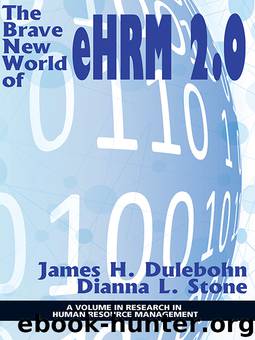The Brave New World of EHRM 2.0 by Dulebohn James H.;Stone Dianna L.;

Author:Dulebohn, James H.;Stone, Dianna L.;
Language: eng
Format: epub
Publisher: Information Age Publishing
Published: 2018-01-22T00:15:20+00:00
One of the major challenges within e-learning environments is that interactions are mediated via technology, which can reduce the effectiveness of the communication (Stone & Lukaszewski, 2009). Specifically, according to the Yale Model of Communication and Persuasion (Hovland, Janis, & Kelley, 1953), for effective communication to occur, the targets of the message must attend to the message, comprehend its meaning and accept it. The effectiveness of these processes can be reduced when communication is online. For example, when communication is electronic, there are many cues that are not available to those in the environment, such as voice inflection, mannerisms, and eye contact. In addition, e-learning interactions often occur in the form of email, which is a one to one communication tool, or in group discussion boards or chats, which are easy for trainees to ignore. In fact, Stone and Lukaszewski (2009) stress that with electronic messages, the target of these messages will be less likely to attend to these messages than with traditional face-to-face communication. In addition, electronic communication can be harder to comprehend than face-to-face communication, and less likely to change attitudes and behaviors.
Finally, one of the hallmarks of effective learning and training is the development of a shared learning environment where learning occurs as trainees work together to create and share knowledge (Liedner & Jarvenpaa, 1995). In fact, Kraiger (2008) has argued that contemporary e-learning places a new emphasis on social interaction, as the learning process can potentially be more social in nature—with learners creating shared meaning based on their online interactions with instructors and peers. The challenge is that many e-learning programs are designed as electronic repositories of information where communication is one way, where trainees interact with course content in online audio, video, and text repositories rather than with peers and instructors. This one-way communication can reduce learning effectiveness. A number of studies have demonstrated the benefits of designing e-learning environments that support and encourage interaction, including greater information processing and attention to communication during e-learning, stronger feedback, and increased learning (Johnson et al., 2008; Piccoli et al., 2001). The review of the research in this area is organized by instructor interaction and peer interaction.
Instructors. The instructor can play a very important role in supporting communication and interaction in e-learning. First, although many e-learning initiatives are done independently, and in isolation, research has found that trainees who had an instructor present during an e-learning course were more satisfied than those who received only computer simulations (Gupta & Bostrom, 2013). In addition, Arbaugh (2001) argues that instructor communication, his or her encouragement of peer interaction, using student names, and providing feedback can reduce the social and psychological distance between learners. For example, research has found that adult vocational students felt that instructor feedback was positively related to their learning (Inayat, Amin, Inayat, & Salim, 2013). In addition, with respect to affective reactions to the training, one research study found that increased interaction with the course instructor was positively related to both course satisfaction, and utility judgments (Arbaugh & Rau, 2007).
Download
This site does not store any files on its server. We only index and link to content provided by other sites. Please contact the content providers to delete copyright contents if any and email us, we'll remove relevant links or contents immediately.
Hit Refresh by Satya Nadella(8854)
The Compound Effect by Darren Hardy(8508)
Change Your Questions, Change Your Life by Marilee Adams(7371)
Nudge - Improving Decisions about Health, Wealth, and Happiness by Thaler Sunstein(7242)
The Black Swan by Nassim Nicholas Taleb(6763)
Deep Work by Cal Newport(6563)
Daring Greatly by Brene Brown(6222)
Rich Dad Poor Dad by Robert T. Kiyosaki(6174)
Principles: Life and Work by Ray Dalio(5961)
Man-made Catastrophes and Risk Information Concealment by Dmitry Chernov & Didier Sornette(5646)
Playing to Win_ How Strategy Really Works by A.G. Lafley & Roger L. Martin(5497)
Digital Minimalism by Cal Newport;(5389)
Big Magic: Creative Living Beyond Fear by Elizabeth Gilbert(5351)
The Myth of the Strong Leader by Archie Brown(5237)
The Slight Edge by Jeff Olson(5200)
Discipline Equals Freedom by Jocko Willink(5156)
The Motivation Myth by Jeff Haden(5001)
Stone's Rules by Roger Stone(4855)
The Laws of Human Nature by Robert Greene(4772)
